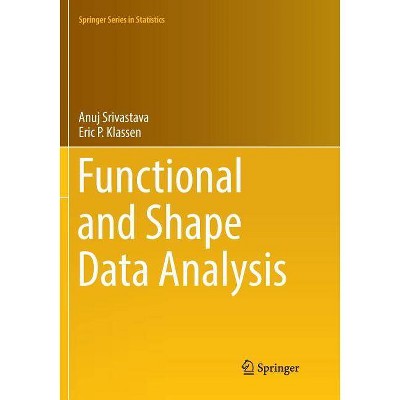The Statistical Analysis of Functional MRI Data - (Statistics for Biology and Health) by Nicole Lazar (Hardcover)

Similar Products
Products of same category from the store
AllProduct info
<p/><br></br><p><b> About the Book </b></p></br></br><p>This book is a primer for readers interested in learning more about this fascinating subject and the many statistical challenges inherent in functional neuroimaging data. It presents the basics of technique and surveys popular statistical approaches.</p><p/><br></br><p><b> Book Synopsis </b></p></br></br>The study of brain function is one of the most fascinating pursuits of m- ern science. Functional neuroimaging is an important component of much of the current research in cognitive, clinical, and social psychology. The exci- ment of studying the brain is recognized in both the popular press and the scienti?c community. In the pages of mainstream publications, including The New York Times and Wired, readers can learn about cutting-edge research into topics such as understanding how customers react to products and - vertisements ("If your brain has a 'buy button, ' what pushes it?", The New York Times, October19,2004), howviewersrespondtocampaignads("Using M. R. I. 's to see politics on the brain," The New York Times, April 20, 2004; "This is your brain on Hillary: Political neuroscience hits new low," Wired, November 12,2007), howmen and womenreactto sexualstimulation ("Brain scans arouse researchers,"Wired, April 19, 2004), distinguishing lies from the truth ("Duped," The New Yorker, July 2, 2007; "Woman convicted of child abuse hopes fMRI can prove her innocence," Wired, November 5, 2007), and even what separates "cool" people from "nerds" ("If you secretly like Michael Bolton, we'll know," Wired, October 2004). Reports on pathologies such as autism, in which neuroimaging plays a large role, are also common (for - stance, a Time magazine cover story from May 6, 2002, entitled "Inside the world of autism").<p/><br></br><p><b> From the Back Cover </b></p></br></br><p></p> <p>One of the most intriguing questions facing modern science is the inner workings of the human brain. Functional magnetic resonance imaging (fMRI) is a powerful tool used to study the human brain in action. The data produced from mapping the active processes within the brain present many challenges to statisticians, computer scientists, engineers and other data analysts, due to their complex structure and the ever-increasing sophistication of the scientific questions being posed by researchers. This book represents the first in-depth discussion of statistical methodology, which it couples with an introduction to the scientific background needed to understand the data.</p> <p>Starting from the basic science - where fMRI data come from, why they are so complicated, and the role statistics can play in designing and interpreting experiments - the book gives a detailed survey of the numerous methods that have been applied in the last fifteen years. The analysis of fMRI data features many of the major issues of concern in modern statistics, such as high dimensionality, multiple testing, and visualization. The array of techniques examined in the book ranges from the simple two-sample t-test and the general linear model to hierarchical spatiotemporal models, multivariate methods such as principal components analysis, and Bayesian approaches as they have been used in fMRI. Software, including descriptions of the most popular freeware packages and their capabilities, is also discussed. This book offers researchers who are interested in the analysis of fMRI data a detailed discussion from a statistical perspective that covers the entire process from data collection to the graphical presentation of results. The book is a valuable resource for statisticians who want to learn more about this growing field, and for neuroscientists who want to learn more about how their data can be analyzed.</p> <p>Nicole A. Lazar is Professor of Statistics at the University of Georgia and affiliated faculty of the Center for Health Statistics, University of Illinois at Chicago. She is a prominent researcher in this area, a contributor to the FIASCO software for fMRI data analysis, and heads an fMRI statistics research group at the University of Georgia.</p><p/><br></br><p><b> Review Quotes </b></p></br></br><br><p>From the reviews: </p><p>"This book gives an extensive description of many analysis pathways developed recently in fMRI data processing. The varied topics are described firstly in a very comprehensible fashion for non-statisticians. In addition, most of the explanations are supported by clear and accurate statistical justifications. Thus, statisticians will find in this book the scientific issues which readers are facing when analyzing fMRI data, and neuroscientists will find a summary of many different methods to tackle fMRI data exploration.... It is highly appreciated to be able to read such honest and thoughtful reflections of fMRI data analysis." (Archard, Journal of Statistical Software, January 2009, Vol. 29, Book Review 3).</p><p>"...I recommend this book. It serves as an overview of current statistics-related research in a field that is advancing rapidly and is both scientifically and technologically very complex, thereby filling a need that had not yet been met by any other book. The author cites widely from both statistical and neuroimaging literature (284 references total)... . The author states that her goal for this book was 'to provide an introduction to functional magenetic resonance imaging, aimed at statisticians, that would highlight the important scientific issues and survey the common...analysis pathways' (p. VIII). The author has in large part done a very commendable job of attaining this goal." ( Journal of the American Statistical Association, Dec. 2009, Vol. 104, No. 488)</p><p>"This book attempts to provide an easy-to-read introduction to fMRI from a statistician's perspective. ... this book does a good job in providing a basic introduction to fMRI for the statistician who is willing to learn about an area where his/her services are actively sought and needed." (Ranjan Maitra, Technometrics, Vol. 53 (2), May, 2011)</p><br>
Price History
Price Archive shows prices from various stores, lets you see history and find the cheapest. There is no actual sale on the website. For all support, inquiry and suggestion messagescommunication@pricearchive.us




















